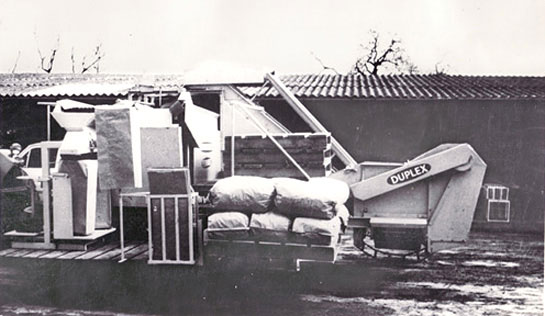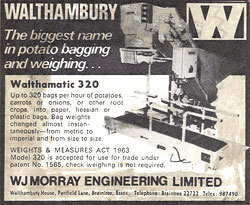 Walthambury Forms Part of W J Morray Engineering Ltd
Walthambury Forms Part of W J Morray Engineering Ltd
And was created from a combination of technical ingenuity, creative problem solving and steadfast business sense when Mr Ray Jackman, then a consultant engineer joined forces with a local farmer, W. C. Halls of Walthambury Farm, near Great Waltham, Essex.
Along with Mr Tony Monk, the head engineer for Mr Halls at Walthambury Farm, they designed and produced the first Walthambury potato weigher in 1964. Following its acceptance by local farmers a pallet attachment was also developed.
This was used with a Massey Ferguson MF11 potato harvester to weigh, bag and palletise in one easy process. Operations that previously would have to be conducted separately in a lengthy and tortuous process.
Soon the design was adapted to work with other potato harvesters like those produced by Grimme and Whitsed, like the example shown below which dates from 1965.
Whitsed Duplex Potato Harvester fitted with Walthambury Bagging & Palletizing System. As the success of Walthambury’s harvester mounted weighing machines grew Tony Monk set to work designing the first of a series of packing house bagging machines that would lead to the modern M720 and M550 machines we see today; the Walthambury 15, a machine with four filling heads mounted on a rotating turntable which, with trained operators, could weigh and fill up to 600 bags an hour.
 Some examples of this machine are still in service to this day as reliable as ever. From this small beginning the Walthambury range of agricultural machinery was born. Always striving for innovation and solutions to age old farming problems.
Some examples of this machine are still in service to this day as reliable as ever. From this small beginning the Walthambury range of agricultural machinery was born. Always striving for innovation and solutions to age old farming problems.
Soon other equipment was designed, such as the oscillating spreader elevator, conceived to make the most of available storage space, and the ‘Nodding Donkey’ W30E Box Loader as well as various pick-up units for use with potatoes, carrots, onion and feed cubes.
Morray was Formed
Morray was formed in 1965 with the intention of acting as a design and development consultancy for the bottling and air conditioning markets. As a result of a quirk of fate shortly after starting the company, the founder through a farming friend came upon a revolutionary device for bagging vegetables that had been designed by the farmer’s mechanic.
At the time nothing similar existed so it was considered that, with some development and marketing, the machine could have significant sales potential both in the agricultural and industrial markets.
By 1967 the machine was selling well and a fundamental decision to concentrate the company’s resources on developing bagging and weighing units was taken. As new bagging and weighing products were designed it became obvious that related ancillary equipment would be required.





